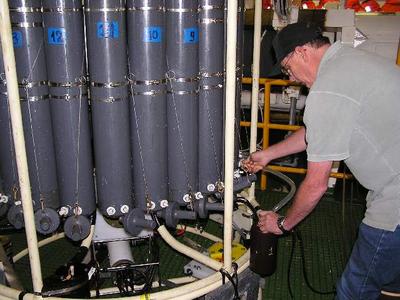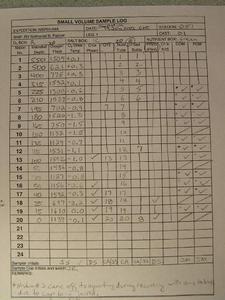17 July, 2003
Call me sample cop. My beat is the Baltic Room of the R/V Palmer.
My job is simple: I keep the order.
I record data too. My work begins with the retrieval of each
rosette. For the deeper water casts when all 24 bottles have been
opened, making sure that every bottle is sampled for the appropriate
variable in the correct sequence gets a bit hectic at times.
On the day watch it usually goes something like this:
1. Dr. Jim Swift (Chief Scientist) begins the process by
drawing a sample from a Niskin Bottle on the rosette into a small
flask that will be used to measure the amount of dissolved oxygen in
the sea-water while observing the temperature of the water too;
2. Dr. Dean Stockwell (University of Alaska, Fairbanks)
collects chlorophyll and phytoplankton;
3. Jeremy Mathis (graduate student from the University
of Miami) obtains DOM (dissolved organic matter) and POM (parcticulate
organic matter) specimens; and finally,
4. Craig Aumack (graduate student from the University of
Texas, Austin) takes nutrient, salt, Oxygen 18, Carbon 13, and
Nitrogen 15 samples.
In reality, everyone takes turns and pitches-in to help with whatever
needs to be done on each cast. Sometimes I even draw samples. But
my job is mainly to help them keep track of what bottle and sample
type needs to be done next. To facilitate that, I have a data chart
for each station that I record everything from the flask number and
draw temperature of Jim's dissolved oxygen to checking-off the
appropriate Niskin Bottle that Dean has taken his chlorophyll sample
from.
From the TV monitor in my room, I can see that it's time for me to
put on my badge, head down to the Baltic Room, and keep the order for
another cast.

Jim Swift adding chemical reagents to fix oxygen sample.

Dean Stockwell obtaining chlorophyll sample.

The sample cop's data form.
Contact the TEA in the field at
.
If you cannot connect through your browser, copy the
TEA's e-mail address in the "To:" line of
your favorite e-mail package.
|
